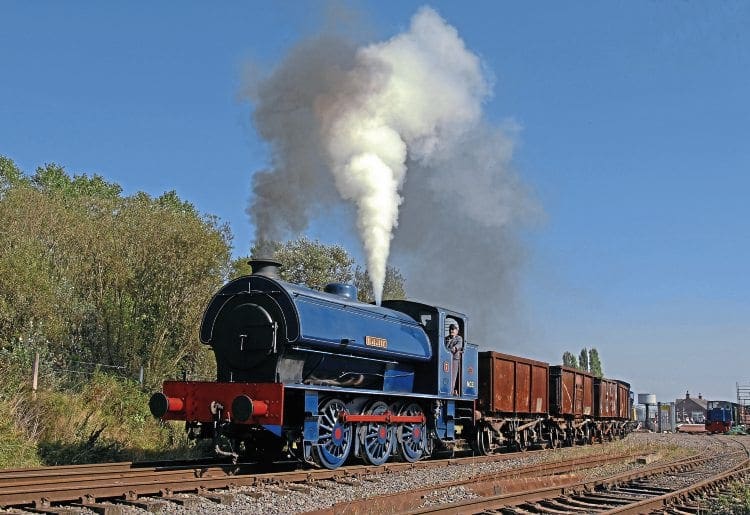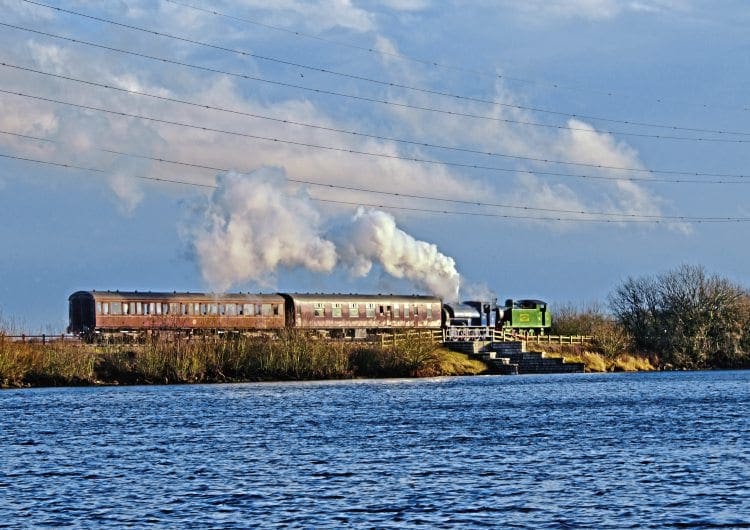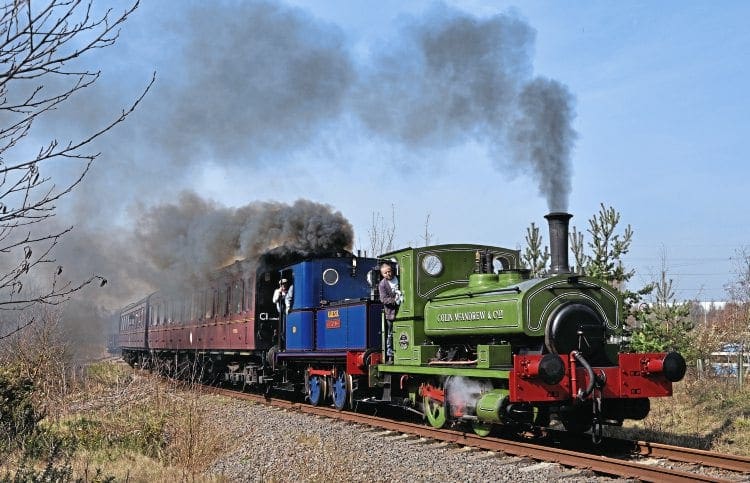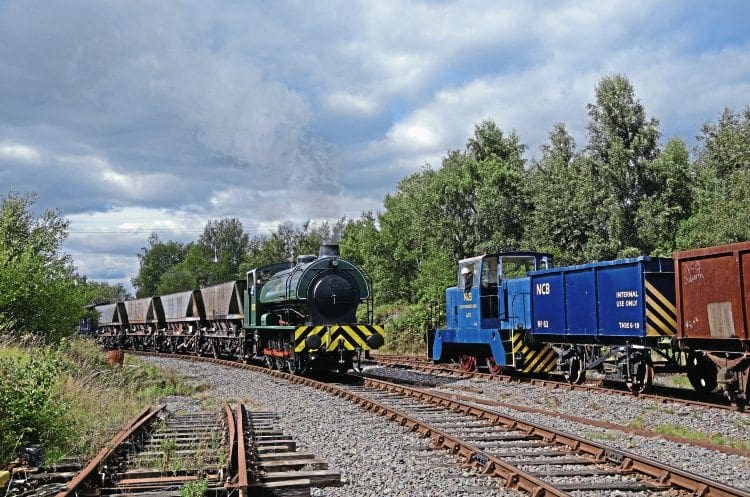With its origins stretching back as far as 1959, the Chasewater Railway has come a very long way in almost six decades. From a low point in the early 1980s when the railway effectively closed, it has bounced back with a vengeance, to the point where its volunteers’ efforts have received royal recognition. Gary Boyd-Hope explains.
ON THE evening of June 1, at the Chasewater Railway’s Brownhills West headquarters, a gathering of the line’s working members sat with mouths agape and expressions ranging from shock to delight as chairman Mark Sealey revealed that the railway had been selected to receive the Queen’s Award for Voluntary Service.
For the small band of dedicated volunteers that give up their free time to run trains over this two-mile length of former colliery railway, recognition for their efforts does not come much higher than this.

It is most certainly a far cry from the days of the mid-1980s when the number of active volunteers was down to single figures and the railway was forced to sell off a number of items of rolling stock simply in order to survive.
Monthly Subscription: Enjoy more Railway Magazine reading each month with free delivery to you door, and access to over 100 years in the archive, all for just £5.35 per month.
Click here to subscribe & save
How times change!
Early days
The Chasewater Railway of today was born out of the vision of one man – Noel Draycott. A resident of Swanley in Kent, Draycott was the brains behind the Railway Preservation Society (RPS), a national organisation that had been created to try and co-ordinate the efforts of railway preservationists around the UK.
The idea was that the RPS would be formed of regional groups, or districts, which would then set up their own base of operations, preferably on a section of railway that could be leased for operation by the RPS. The first such district to be established was the Railway Preservation Society – West Midlands District, which had its inaugural meeting in Stafford on November 21, 1959.
The RPS was a commendable, if somewhat unworkable, idea. Only two other district groups managed to achieve anything significant: the Scottish Railway Preservation Society prospered to eventually establish the successful Bo’ness & Kinneil Railway, and the London Railway Preservation Society, which went on to create the Quainton Railway Society collection at today’s Buckinghamshire Railway Centre.
As for the West Midlands District, by June 1960 it had secured a rail-connected site at Hednesford, near Cannock, where it moved its two derelict six-wheeled coaches that had been gifted to it by the National Coal Board. These were later joined in 1961 by LNWR 0-6-2 ‘Coal Tank’ No. 1054, ex-LBSCR ‘E1’ 0-6-0T No. 110 (which from 1927 had worked for the Cannock & Rugeley Colliery Company at Cannock Wood Colliery as its No. 9) from 1963, and a host of other items of rolling stock and artefacts.
As the collection grew, additional space became a priority along with the need for a running line.
It was time to move.
Destination Chasewater
The need for a new base eventually resulted in three branch lines being given serious consideration as possible homes. In the end the group plumped for a truncated section of the Midland Railway’s Aldridge to Brownhills branch along the shores of Norton (now Chasewater) Reservoir. Dating back to 1881, the line had been built by the Cannock Chase & Wolverhampton Railway, with part built by the Midland, and for years had served several NCB collieries until the cessation of coal traffic in the early 1960s.
The RPS was able to secure a 25-year lease on a two-mile section in 1964, at a time when the Aldridge-Brownhills Urban District Council was developing an area of public parkland around the reservoir, so the two projects complemented each other well.
As the new site at Chasewater was cleared the stock from Hednesford was gradually transferred, eventually being completed by 1970. The first public open day on the new site was on June 29, 1968 when ex-Turner & Newall (Trafford Park) Hawthorn Leslie 0-4-0ST Asbestos (2780/1909) did the honours.
As the number of open days increased and the RPS started to operate the railway on a regular basis, a wholly owned subsidiary known as the Chasewater Light Railway Company was set up to run the line on behalf of the group.
The membership, meanwhile, felt that the somewhat long-winded title of Railway Preservation Society – West Midlands District was in need of change, and the Chasewater Light Railway Society was born.
A high point for the rebranded society came in 1975 when its restored former Maryport & Carlisle Railway six-wheeler was sent to represent Chasewater at the Stockton & Darlington 150th anniversary cavalcade at Shildon. However, behind the scenes, events were taking a different turn.
Vandals and theft
If establishing an operating railway was not difficult enough, the Chasewater Railway had to combat repeated attacks by vandals and even theft. In the words of the railway’s operations director Christian Hatton, “if it wasn’t bolted down it got nicked”, and this is no exaggeration. A prime example was the
ex-GWR parachute water tower that the society had obtained from Cleobury Mortimer, and which was cut up and carted off by metal thieves before they had the chance to re-erect it.
A secure compound was established at the railway’s then headquarters at the old Brownhills West station, where a platform had been erected, but there was no covered accommodation and all restoration and maintenance was carried out in the open air.

A Manpower Services Commission scheme was accepted to build a new running shed as the 1980s got underway, but this only added to the headaches as the levels of theft increased during the duration of the project.
Yet things were going to get worse.
Dark days
About three-quarters of a mile from Brownhills West the railway crosses what is known as the Causeway, at the northern end of the Chasewater reservoir. This had originally been built as an embankment over the Great Crane Brook, but later became a true causeway when the high water level of the reservoir was raised in the early years of the last century.
Erosion had always plagued the Causeway, and regular repairs and strengthening, usually using colliery waste, were required throughout its existence. By 1982 the Causeway’s condition had deteriorated to such a degree that the society was forced to abandon it, having no funds to continue its upkeep. The rails were lifted and subsequently sold for scrap.
It was the beginning of a very dark period for the railway.
As things turned out, 1982 proved to be a very difficult year for the railway. Having lost the use of the Causeway, with the result that the line was truncated into a ¾-mile stub, the volunteers were also being stifled by a ‘planning blight’ that was preventing any further developments at Brownhills West.
Two years previously proposals for a new publically funded relief road to the north of Birmingham were announced; Brownhills West station lay directly in the path of one of the six route options. With a realistic chance that part of the station site would be subject to a compulsory purchase for the new motorway, the railway was prohibited from carrying out any significant work on the site.
As the 1982 season approached its close, the railway was facing a very real crisis. Visitor numbers had dwindled to the point where only two fare-paying passengers were carried on the last train of the day during one Saturday that October, and the only way to pay for coal for the loco was to have a whip round among the volunteers.
Things finally came to a head shortly afterwards when Asbestos derailed on a set of points. It was clear that a considerable amount of work was required to make the railway fit for purpose, and the decision was taken to suspend the running of trains for the foreseeable future. It would be another three years before trains would run again.
A new beginning
The society plodded on doing what it could at Brownhills West during this period of closure, but with membership having dropped by 50% and the number of active volunteers falling as low as seven, it was clear that action would be required if the Chasewater Railway was to have any future.
To raise urgent funds a number of items of rolling stock were disposed of. The ‘E1’ had left in the late 1970s, a LNWR Travelling Post Office went to Birmingham Railway Museum at Tyseley, and a small ‘Planet’ found its way to the Tollerton Farm Railway in Nottinghamshire. Other items were bought by individual members in order that they could stay at Chasewater, pending a return to ‘brighter’ times.
By 1985 a number of those members that were left agreed that a complete restructure of the society and operating company was required. Thus the Chasewater Light Railway & Museum Company was formed with the specific aim of merging the remaining assets and liabilities of the old society and the operating company back into a single group – a registered charity that remains at the heart of the railway today.
The first trains under the new company ran that year. Brighter times were on their way.
It has been said that the construction of the Birmingham Northern Relief Road, or the M6 Toll to you and me, was the main catalyst behind the rejuvenation of the Chasewater Railway. Indeed, the money the railway received as compensation for the motorway lopping off part of its Brownhills West station has transformed the railway’s public face, but the line’s rebirth began earlier than that.
A significant development in the re-emergence of the railway occurred in May 1993 when, supported by Walsall Council, the railway began the task of rebuilding the Causeway, which had been completely washed away in the years since its abandonment.
Christian Hatton recalls it vividly: “The Causeway was one of the first jobs I was involved with as a 16-year-old volunteer.
“I hadn’t been working on the railway for very long and here I was, helping massive dump trucks to drop their loads to create the access road to the Causeway.
“We brought in fill material (around 120,000 tons) for compaction and grading, and got the main body of the Causeway built in under a year. It was one of the largest civil engineering jobs carried out by any preserved railway until that point.”
Two years after work on the Causeway began, the first trains to the new Norton Lakeside station – the approximate halfway point on the line – ran in December 1995.
Meanwhile, the relief road saga was still ongoing, Midland Expressway Ltd having won the rights to build it back in 1989. The preferred route selected was the one that bisected the Brownhills West site and, following a number of legal challenges completely incidental to the railway, the green light was given for the construction of the new motorway in 1997.
Step forward the railway’s then general manager, Steve Organ – a man gifted in the art of negotiation, or as Christian Hatton describes him “a man who was brilliant at getting a lot for very little”. The Brownhills West site was, at the time, a hotchpotch of Portacabins and grounded van bodies, but Steve was able to work out the square footage of each structure’s footprint, which helped him calculate a figure for the land that the railway would lose to the new road, and the cost of relocating the facilities to a new site.
Handsome compensation
The upshot was that the railway was handsomely compensated for the inconvenience, with the money being used to develop a new Brownhills West station just a few hundred yards north of the old site. The M6 Toll now runs directly through where the old platform once stood, although there is nothing to see now as the road runs through a cutting at this point. However, eagle-eyed motorists will notice the roofline of the railway’s heritage centre, almost butting up to the Toll Road’s boundary fence.
The money received from the motorway paid for the Brownhills West station building (which today houses the railway’s offices, ticket office/booking hall, shop, toilets and booming restaurant), all the required earthworks for the new site, new fencing and modified trackwork. The first trains from the new facility ran in 2001, just a year after construction on the motorway began.
Yet the railway wasn’t finished yet.
Shortly after the work on the new Brownhills West station was completed, the railway applied for a European Regional Development Fund grant to erect a new building to house a heritage centre, workshop and museum. In order to qualify for the cash injection the railway was required to supply a certain amount of match funding, and to achieve this it took the innovative step of putting a price on volunteer labour; it was one of the first railways to employ this tactic.
Built to resemble a classic running shed, complete with built-in water tower, the new building features six roads – two of which form the workshop, with the other four making up the heritage centre, where the wooden-bodied stock and out-of-use locomotives are displayed, feeding in to the railway’s full accredited and ever-growing museum.

Other work completed at this time was the erection of Chasewater Heaths station and the building of a short extension from ‘The Heaths’ to Chasetown (Church Street).
The Chasewater Railway was back!
A change of direction
Back it may have been, but the revitalised Chasewater Railway was effectively still just, for want of a better term, another preserved railway. The motive power was a mixture of industrial steam locomotives and ex-BR main line diesels, with a number of DMUs thrown in (the railway has had 11 all told), and in spite of its enviable new facilities, the railway failed to stand out in a growing crowd.
The author recalls a visit made in the early 2000s when the service train consisted of the line’s Sentinel 4wVBT and a DMU trailer with – and I have to be honest here – a pretty rough paint job. It was not an inspirational visit, and with the yard at Brownhills full of redundant diesels, I did not come away with any desire to return.
“We were great at building things back then,” says Christian Hatton, “but we weren’t that good at actually running a railway. We were still really just playing trains, which is what the railway had always done.”
Things started to change during the latter half of the decade when Mark Sealey succeeded Steve Organ as general manager.
“Steve had done a superb job in turning the railway’s fortunes around, but I knew that there was still so much potential to unlock,” Mark explained. “When you looked beyond the DMUs we had a fine collection of interesting industrial steam and diesel locos from across the region’s industries, we had the basis of a genuine NCB ‘paddy train’ in the Victorian coaches, and we were at the heart of the Coal Board’s ‘Staffordshire Blue’ area. That was our real heritage, and that became the core of our future direction.”
And so the DMUs and main line diesels left, leaving only a Class 08 and a couple of DMU centre cars, which form the basis of the railway’s main passenger set, together with a Mk1 brake. The focus of the railway turned towards telling the story of the industries of the West Midlands and Staffordshire, while at the same time securing some of the rail infrastructure heritage of the region that related to the movement of coal. Chasewater would no longer be ‘just another railway’, but instead become one of the leading industrial railways in the UK, its name being spoken along with the likes of Tanfield, Middleton and Foxfield.
The railway today
Few who remember the ‘old’ Chasewater Railway of the 1970s and 1980s would recognise the line it has become in the last decade. Access to Brownhills West is gained through the ever-popular Chasewater Country Park, the railway having its own large car park. The station area comprises 10 roads, with two bay platforms (1 and 2) and a through platform (platform 3).
The impressive heritage centre is accessed from the southern end of platform 3, behind which operates the 2ft-gauge Chasewater Narrow Gauge Railway; a line running former underground man-riders and diesel locos.
At the northern end of the station can be seen the line’s running shed and adjacent signalbox, formerly of Madeley Junction on the West Coast Main Line, which was donated to the railway in 2006. As part of an ongoing re-signalling of the railway, the reconstructed ’box, which incidentally served the branch to Silverdale Colliery, had its lever frame connected up last year, and is now used for controlling movements within the confines of Brownhills West.
Departing from Brownhills West trains head north-westwards for the first quarter-mile, running through the edge of the country park then swinging north-easterly, passing over the rebuilt Causeway – with great views across the water – before arriving at Norton Lakeside Halt. This unmanned request stop is a little over a mile from Brownhills West and sits at a point where a number of the footpaths and tracks through the park converge.
As the train continues to scribe a clockwise arc around the reservoir, it is interesting to note how the views have changed in the past 20 years. Much of the industry that dominated this area has now gone, and instead the train rolls through what is known to crews as the Windy Woods, past the open heathland of the park where deer roam freely, and into Chasewater Heaths station.

‘The Heaths’ is the railway’s other main station, and was the terminus until the opening of the Chasetown extension in 2000. As the train runs into the station it passes the yard
and bay platform on the left side, with a run-round loop/siding on the opposite side. Like Brownhills West, the main building comprises a booking office, small shop and large franchised refreshment room, while upstairs a large model railway is housed.
At the Chasetown end of the platform stands the former Hademore signalbox, which once stood on the Trent Valley line. Like that at Brownhills West, the ’box is nearing the end of a full restoration, including the installation of a 15-lever frame, formerly at Hednesford. The railway was fortunate to be offered much of the signalling equipment from the Cannock Chase line by Network Rail, including Brereton Sidings signalbox, when that route was re-signalled in 2014. Much of this is being incorporated into the two ’box restorations, as well as the re-signalling of the railway.
The final part of the journey skirts the edge of the country park and takes the train south-easterly towards Chasetown (Church Street). This is journey’s end for outbound passengers, with the station comprising just a single platform and run-round loop. Here, the loco will run round before starting its return run back to Brownhills West.
Re-signalling of the railway is just one of many projects that the Chasewater Railway is looking to complete in the short-term. At Brownhills West there is a plan to erect a single-road carriage shed next to the overflow car park boundary, which would be capable of housing the line’s operating carriage fleet. This was expanded further in 2015 with the acquisition of a Mk1 suburban brake, which when overhauled will primarily be used with the smaller locomotives for off-peak and gala services.
Exciting developments
The heritage centre too is earmarked for attention, during which the workshop side will be completely separated from the rest and better use made of the space for interpretation and display of the growing collection. This will centre on the industrial railways of the region; Chasewater is home to the largest collection of ex-Burton brewery locomotives anywhere in the UK.
At Chasewater Heaths designs are being put together to provide a platform canopy, while a former Midland Railway lattice iron footbridge from Bagworth on the Leicester to Swannington line will be erected to prove direct access to a proposed second platform.
However, the most exciting development concerns the expansion of the yard at ‘The Heaths’. A programme is in place that will see a large bank of earth removed, which will allow two further roads to be added to the current three, with the possible provision of a small engine shed and coal yard. This area will be used to house the railway’s growing collection of coal wagons; the railway is seeking to tell the full story of the movement of coal by rail from wooden-bodied five and seven-plank wagons, through 16T minerals to the ‘Merry-Go-Round’ hoppers.
At present the railway is home to five of the ‘HAA’ hoppers, which is the largest rake in preservation, and the aim is to increase it to at least six. The running of demonstration coal trains is a central attraction to the railway’s galas and annual Coal Train weekend each June, and the ability to provide shunting demonstrations at Chasewater Heaths will further add to the line’s offering.
With the imminent return of three of the line’s steam locomotives to give a working
fleet of six, and work ongoing to get the wooden-bodied ‘paddy train’ into traffic, the railway is certainly not sitting on its laurels.
Royal recognition
Having bounced back from the brink of near oblivion, it is all the more fitting that the railway was the recipient of the aforementioned Queen’s Award for Voluntary Service. In the words of Mark Sealey: “It’s not just an award for those of us who run the railway today, but recognition for what those who are no longer with us did to get us where we are.
“We are small, we are industrial, but we get the job done, so the award for us is a bit like Leicester City winning the Premier League.”
I couldn’t have put it better myself. ■
The Railway Magazine Archive
Access to The Railway Magazine digital archive online, on your computer, tablet, and smartphone. The archive is now complete – with 120 years of back issues available, that’s 140,000 pages of your favourite rail news magazine.
The archive is available to subscribers of The Railway Magazine, and can be purchased as an add-on for just £24 per year. Existing subscribers should click the Add Archive button above, or call 01507 529529 – you will need your subscription details to hand. Follow @railwayarchive on Twitter.




